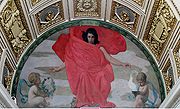
Edward Simmons (painter)
Encyclopedia


Mural
A mural is any piece of artwork painted or applied directly on a wall, ceiling or other large permanent surface. A particularly distinguishing characteristic of mural painting is that the architectural elements of the given space are harmoniously incorporated into the picture.-History:Murals of...
work. He was born in Concord, Massachusetts
Concord, Massachusetts
Concord is a town in Middlesex County, Massachusetts, in the United States. As of the 2010 census, the town population was 17,668. Although a small town, Concord is noted for its leading roles in American history and literature.-History:...
, the son of a Unitarian minister.
He graduated from Harvard College in 1874, and was a pupil of Lefebvre and Boulanger in Paris
Paris
Paris is the capital and largest city in France, situated on the river Seine, in northern France, at the heart of the Île-de-France region...
, where he took a gold medal. In 1894, Simmons was awarded the first commission of the Municipal Art Society
Municipal Art Society
The Municipal Art Society of New York, founded in 1893, is a non-profit membership organization that fights for intelligent urban planning, design and preservation through education, dialogue and advocacy in New York City....
, a series of murals — “Justice,” “The Fates” and “The Rights of Man” for the interior of the Criminal Courthouse at 100 Centre Street in Manhattan. This court is the criminal branch of New York Supreme Court
New York Supreme Court
The Supreme Court of the State of New York is the trial-level court of general jurisdiction in thestate court system of New York, United States. There is a supreme court in each of New York State's 62 counties, although some smaller counties share judges with neighboring counties...
where many New Yorkers serve on Jury Duty. Later Simmons decorated the Waldorf-Astoria hotel in New York
New York
New York is a state in the Northeastern region of the United States. It is the nation's third most populous state. New York is bordered by New Jersey and Pennsylvania to the south, and by Connecticut, Massachusetts and Vermont to the east...
, the Library of Congress
Library of Congress
The Library of Congress is the research library of the United States Congress, de facto national library of the United States, and the oldest federal cultural institution in the United States. Located in three buildings in Washington, D.C., it is the largest library in the world by shelf space and...
, Washington, D.C.
Washington, D.C.
Washington, D.C., formally the District of Columbia and commonly referred to as Washington, "the District", or simply D.C., is the capital of the United States. On July 16, 1790, the United States Congress approved the creation of a permanent national capital as permitted by the U.S. Constitution....
, and the Capitol at Saint Paul, Minnesota
Saint Paul, Minnesota
Saint Paul is the capital and second-most populous city of the U.S. state of Minnesota. The city lies mostly on the east bank of the Mississippi River in the area surrounding its point of confluence with the Minnesota River, and adjoins Minneapolis, the state's largest city...
.
In the year 1914 he travelled with Childe Hassam
Childe Hassam
Frederick Childe Hassam was a prolific American Impressionist painter, noted for his urban and coastal scenes. Along with Mary Cassatt and John Henry Twachtman, Hassam was instrumental in promulgating Impressionism to American collectors, dealers, and museums...
to view the Arizona desert paintings of the rising California artist, Xavier Martinez
Xavier Martinez
Xavier Timoteo Martínez was a California artist active in the late 19th and early 20th century. He was born in the Mexican city of Guadalajara, Jalisco, and, after becoming a naturalized citizen of the United States, died in Carmel-by-the-Sea, California...
at his Piedmont studio.
Simmons was a member of the Ten American Painters
Ten American Painters
The Ten American Painters, generally known as The Ten, resigned from the Society of American Artists in late 1897 to protest the commercialism of that group's exhibitions, and their circus-like atmosphere...
, who, as a group, seceded from the Society of American Artists
Society of American Artists
The Society of American Artists was an American artists group. It was formed in 1877 by artists who felt the National Academy of Design did not adequately meet their needs, and was too conservative....
. He was also considered a contributor to the style known as the American Renaissance
American Renaissance
In the history of American architecture and the arts, the American Renaissance was the period in 1835-1880 characterized by renewed national self-confidence and a feeling that the United States was the heir to Greek democracy, Roman law, and Renaissance humanism...
, a movement after the American Civil War
American Civil War
The American Civil War was a civil war fought in the United States of America. In response to the election of Abraham Lincoln as President of the United States, 11 southern slave states declared their secession from the United States and formed the Confederate States of America ; the other 25...
that stressed the relationship of architecture, painting, sculpture and interior design.
Simmons published his autobiography in 1922.

